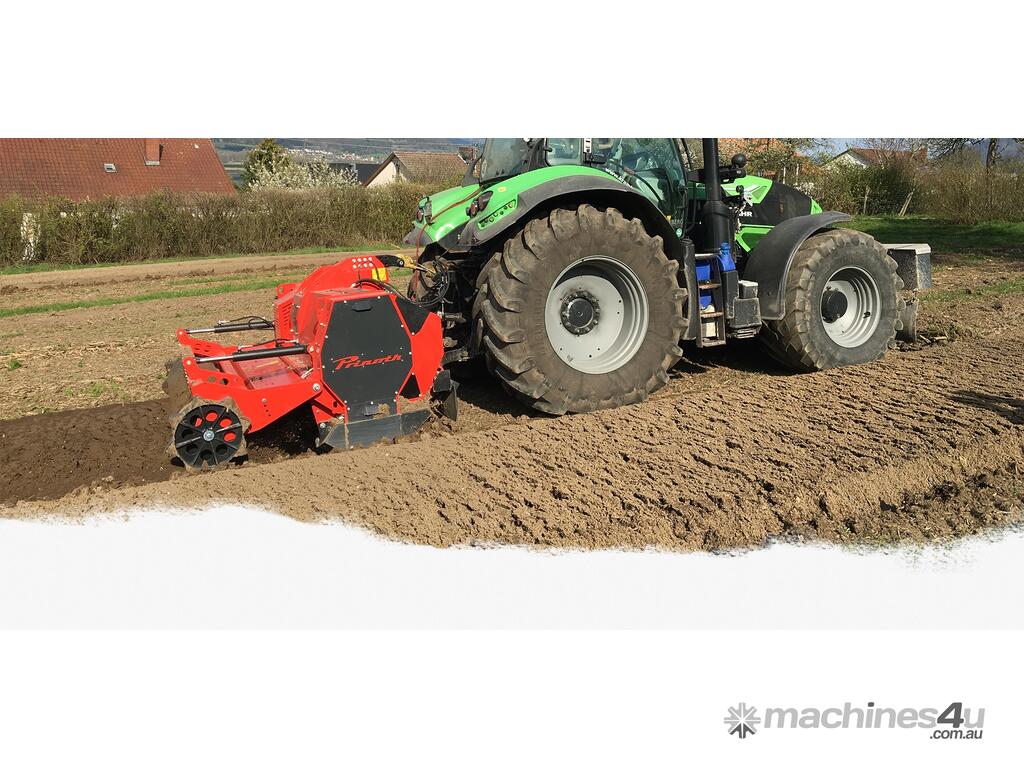The rotovator R800 is developed for carrier vehicles like tractors with a 3-point hitch: power lift CAT III and CAT IV in the power range of 200-360 HP.
The new PRINOTH R800 rotovator has been specially developed for shredding roots and root residues and incorporating them into the subsoil. The shredding as well as the mixing of the biomass takes place in one operation.
Perfect shredding with an optimal cutting pattern is ensured by the UPT tool system, which is arranged on the rotor in a balance-optimized manner. With the proven counter-blade technology from the mulcher portfolio, PRINOTH sets new quality standards with the R800 in terms of shredding and mixing.
Thanks to a wide range of options for tools and housing linings, adapted to the individual operating conditions, operating costs can be significantly reduced. The oil cooler integrated into the housing, easy-to-replace wear plates in the housing and the actively cooled belt drive increase performance and service life even under the toughest operating conditions.
With a working width of 2300 mm (90.6 in), a milling depth of 400 mm (15.7 in) and the option of having the rotor rotate in reverse, the R800 covers a wide range of applications with tractors in the upper power class up to 360 hp.
The previous subsoiler, which was produced until 2020, is known under the product name RF800.
Power range: in HP: 200 - 360
Working width: 2300 mm / 90.6 in
Weight: 4300 kg / 9480 lbs
Working depth up to: 400 mm / 15.7 in
Tools: 52xUPT
3-point hitch: CAT III / CAT IV
Power take off speed: 1000 rpm
Note: Technical data are dependent on equipment and may vary.
Application Areas
Infrastructure measures
Infrastructure measures are any measures that are used to build and maintain infrastructures. Among other things, those include complete or selective clearing or land management in preparation for infrastructure construction work.
Furthermore, it also includes infrastructure maintenance and clearing around existing installations. That includes street and road construction and the expansion of rail networks or airports.
Reclamation
Re-cultivation is the exploitation of land for economic purposes, such as plantations or agriculture. Soil preparation is a common feature of this process.
In many cases, re-cultivation is closely related with the clearance of large areas or forest clearance and also the shredding of stumps and root material. This can either involve secondary vegetation or trees. A mulcher is used to process vegetation on the surface. A rotovator is then used to deal with any remaining vegetation or stumps which are still in the ground, which are then combined with the mulched material and mixed into the soil.
Land clearing
The phrase “land clearing” involves a range of different applications and terms. In many cases, site clearance refers to secondary vegetation and for construction clearance. This may involve forest clearance for areas intended for use such as wind farms, parks, road construction or golf courses.
It may also include applications such as the removal of windblown timber or burnt areas, preparation work for surface mining and of equal importance, amenity areas. Site clearance can also be considered in plantations, arboretums, horticulture and landscaping.
When clearing large areas, no selective mulching takes place, as large areas or parcels with a range of different types of vegetation are processed by the mulcher. In many areas of the world, other methods are used for the same purpose, such as slash and burn, chaining or simply bulldozing the area. When these methods are used, vegetation is uprooted by bulldozers or stretched chains, and then burned or buried. In contrast to these methods, mulching is the process with the lowest degree of intervention in the ecosystem. Whether mulchers or rotorvator are used, the shredded biomass remains and greatly improves the fertility of the soil.
Plantation agriculture
The plantation industry involves a variety of applications. These range from forestry plantations with eucalyptus, pines and similar, to Christmas tree stands and short rotation plantations, oil palm plantations and fruit plantations such as pineapple, bananas, apples, etc.
The use of mulch technology in plantation agriculture may involve mulching all of the vegetation or just the harvest remains and root stocks. Among other things, this involves plant preparation for the next crop.
The soil is also often processed with a rotovator after mulching to also remove the tree stumps and roots in the ground. Cultivated and fertile soil performs better for new seed planting. Root stocks and harvest residues are often extremely obstructive when using machines for maintenance and harvesting. A particular feature in this area is that there are no significant alternatives to our technology for an environmentally and economically sustainable plantation industry.
Stump grinding
This often refers to stump milling, tree stump shredding or root stock recycling. This may involve rootstock processing with a stump grinder on site and leaving the ground material behind.
A second option is to process the stumps in the ground with a rotovator. Another method is to mulch or shred tree stumps or root balls on the surface that have been excavated in a previous process e.g., Using excavators, bulldozers or track loaders.
